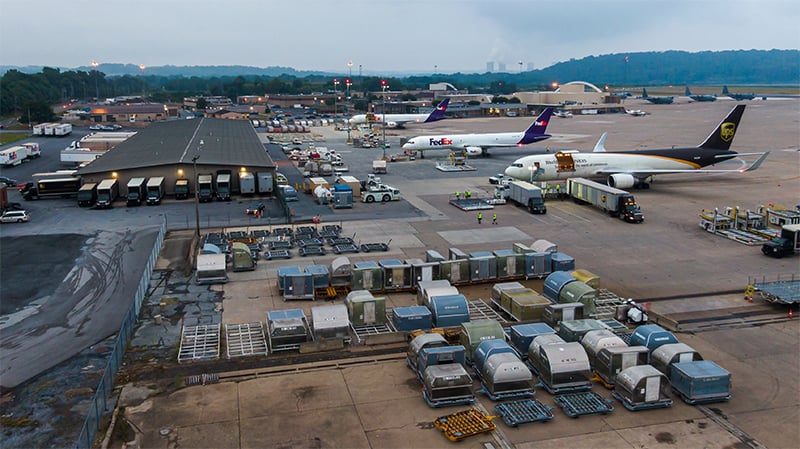Those of us who make our livings managing supply chain, the time of the year between Halloween and New Year’s Eve is always on the tense side. Known as the “Peak Season”, it seems to start earlier and earlier the more people turn to e-commerce.
In our industry, depending on how tightly tied into your supply chain you are, you know when to expect the surcharges (they always come), and even sometimes you can tell when the daily capacity is going to drop. Add on to the usual holiday stress, and it’s another level. But for many of us, we know if we can just get through this 8-week crunch, through the Chinese New Year (CNY), we can start to breathe a little easier. We are almost through. But like everything else, 2020 is not a normal year. Actually, I would think that many of us still haven’t had an easy moment since February 2020, the last CNY, which is when our worlds changed. Maybe forever.

Transport containers being loaded onto trucks from cargo airplanes.
Peak Season Never Really Ended, and It’s Going to Get Worse
As we know now, the 2019-2020 peak season never ended. The CNY got extended by the first round of lockdowns, and while some of the pressure came off, and things got back to what we now know as normal, it wasn’t what we are used to. Surcharges and capacity restrictions in July aren’t things you would normally try to plan for. And now we find ourselves in a situation where an already taxed system is fighting against three major challenges as it tries to right itself. Those challenges are the “traditional” peak season is going to pile onto capacity challenges, the Section 301 Tariff exclusion on 2- and 4-layer PCBs is set to expire on Dec. 31, 2020, and lastly, we are once again looking at an early CNY, one that is surround by COVID uncertainty.
At this point, we are familiar with the capacity challenges that have been the norm since March. We all know that a lack of commercial planes in the air means a restriction in the amount of cargo that can be moved.
This makes moving product out of Asia even more difficult when the entire world is being encouraged to buy online. With all of the big box stores in the U.S. agreeing to not open for Thanksgiving or Black Friday, and most turning to extended online “virtual Black Friday” sales, some lasting over a series of weeks, it puts more product in that reduced space.
If you aren’t working with a supplier that has a strong partnership with one of the big 3 carriers in the U.S., the delivery schedule for your products could be running as long as your production. With all delivery guarantees suspended since Q2, if you don’t have a significant partnership and shipping volume, getting packages in the normal 2-3 days from China isn’t going to happen. At Epec, because we have worked with UPS as a key supplier over the last 15 years, we have put ourselves in a position where our consolidated shipping volume, year-round, allows us to maintain control of our supply chain and minimize, and in many cases avoid, any disruption to our customers.
Peak Season charges are always the first concern that we think about during this time of the year. And this year, we are seeing record high charges. It is estimated that there will be roughly $4.5 billion dollars that are going to be spent on peak charges alone in 2020. That sounds like a high number, but the reality is depending on your supplier’s relationship with their shipping carrier, customers have been paying surcharges since April 2020.
On top of the seasonal charges, there has been concern about the fuel surcharges, which have been steady throughout the year, and are starting to go up as gas prices are increasing. These are the hidden charges that if you aren’t looking for, you don’t see them until they are on your bill. As of writing this blog post, the published rate for UPS Peak Season charge is $1.47/lb., which when you are talking about a product as dense as a printed circuit board will add up quickly if you don’t have the right protections in place.
The only way to be able to work around the current capacity challenges is to be as agile as possible. At Epec, while we prefer to consolidate our shipments out of Hong Kong, we have the ability to move those shipments back to China if we need to be able to quickly increase our capacity. With our own 25+ person office in Shenzhen, China, we are not only working with our Local MA UPS representatives daily, but also with the hubs in Shenzhen, Shanghai, and Hong Kong. It allows us to make real-time decisions so that we can support our customers’ requirements. With how volatile the supply chain has been throughout 2020, real-time information, and options are invaluable.
Section 301 Tariff Exclusions Scheduled to Expire
The new challenge for 2020 that we have never had to deal with during Peak Season is the Section 301 Tariff Exclusions.
In February 2020, an exclusion was given for 2- and 4-layer PCBs as well as some very specific exclusions for LED printed circuit boards. In August, the exclusion was extended for 2- and 4-layer PCBs, through Dec. 31, 2020. In August, the exclusion decision was actually allowed to expire before the system was updated, resulting in some shipments being charged a tariff that then had to be reclassified.
While no one knows what is going to happen, all leading indicators and industry experts believe that the majority of the exclusions given, if not all will be allowed to expire. It was common knowledge that the Trump Administration had been unwilling to consider any further extensions. It would appear that President-Elect Biden is expected to keep all or most of them in place for at least the near future.
Based on the available information, we have been working with customers to try and place orders for at least Q1 inventory levels to avoid having to pay an additional 25% on their PCBs. Because Epec has the ability to manage inventory for customers, as well as managing many customers in bond shipments directly to their warehouses, we can bring production in ahead of the Dec. 31, 2020 deadline and hold that product until you need it. In 2018, it was almost as if there was a gradual increase, with the tariff going from 0% to 10% to 25%. If and when this exclusion expires, it will be directly back to 25% on anything clearing after Dec. 31, 2020. Depending on your PCB spend that could be a large cost impact for Q1 2021.
Chinese New Year is Early Again
This leads to the third leg of this particularly sticky Peak Season. With the CNY starting earlier again this year, on Feb. 12, 2021, we aren’t just worried about Covid-19 extended closures.
At Epec, we typically start planning our CNY production schedules as early as September in any given year. We are not unique in trying to get the majority of our production in ahead of the shutdown, usually as much of the in-process production for the entire month of the shutdown, to manage our customer deliveries.
This year, we are anticipating the holiday to last for at least two weeks, if not a minimum of three. Capacity is going to be an issue not only on the freight and shipping side, but also manufacturing, especially in PCBs. As customers are trying to advance buy for the potential tariff, and pull in production on the CNY shutdowns, that is going to bottle neck in manufacturing.
Again, having the ability to move through our extended supply chain that includes not just mainland China, but also Taiwan, Malaysia, India, the UK, and the U.S., allows us to continue to support customer requests with minimal disruption or cost impacts.
Summary
When I started to write my annual Peak Season message, I jokingly called it the Bermuda Triangle of Peak Season this year. The already stretched capacity and the increased production planning due to the CNY and potential tariffs have created a triangle of challenges that we have to navigate. Add to that mix the ever-changing status of COVID-19 restrictions, lockdowns, etc., we are in a very fluid situation.
The next 12 weeks are going to present a series of challenges many of us have not experienced, or at least not experienced all at once. For our team at Epec, our attack is simple: have and share as much information about the current situation and keep our supply chain partners as agile as we can be to provide options for every challenge.
One of our core values is “Yes, Before No”. That doesn’t mean to just say “yes” to make a customer happy, but as fundamental part of who we are to evaluate every challenge for alternative solutions to keep our customers running smoothly in uncertain times.
Key Takeaways
- Peak Season challenges have intensified since 2020: The traditional holiday surge never fully ended due to global disruptions, creating ongoing freight capacity issues and higher surcharges across the supply chain.
- Freight costs are at record highs: Peak season surcharges and rising fuel costs have significantly increased shipping expenses, particularly for dense products like printed circuit boards.
- Strong carrier partnerships are critical: Epec’s long-term relationship with UPS provides greater control over logistics and the flexibility to reroute shipments in real time to avoid delays.
- Tariff exclusions are expiring: The Section 301 tariff exclusion on 2- and 4-layer PCBs was set to expire at the end of 2020, potentially reinstating a 25% tariff that customers must plan around.
- Early Chinese New Year adds more strain: The 2021 CNY, combined with pandemic uncertainty and tariff pressures, created manufacturing and freight bottlenecks, emphasizing the need for agile supply chain strategies and diversified sourcing.
















